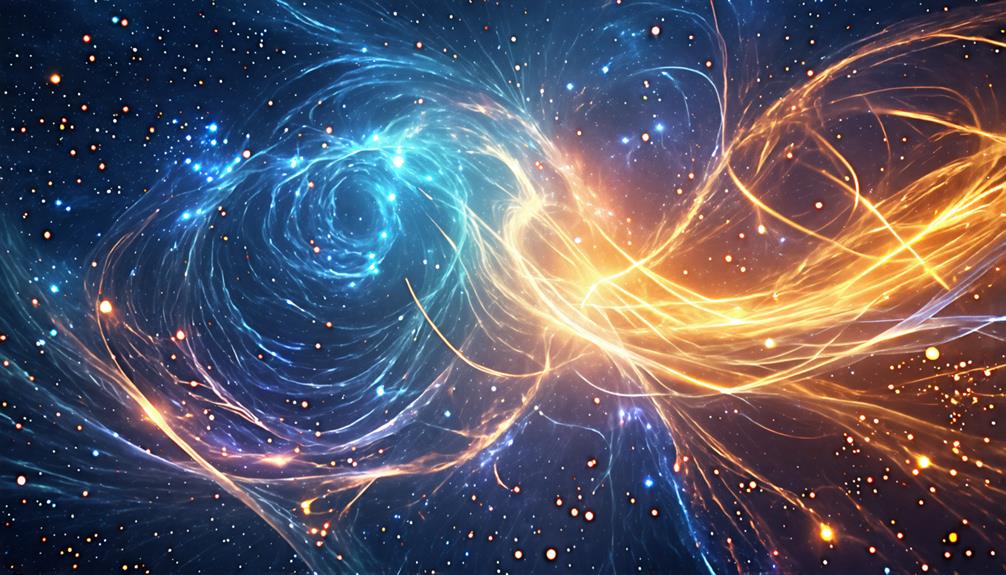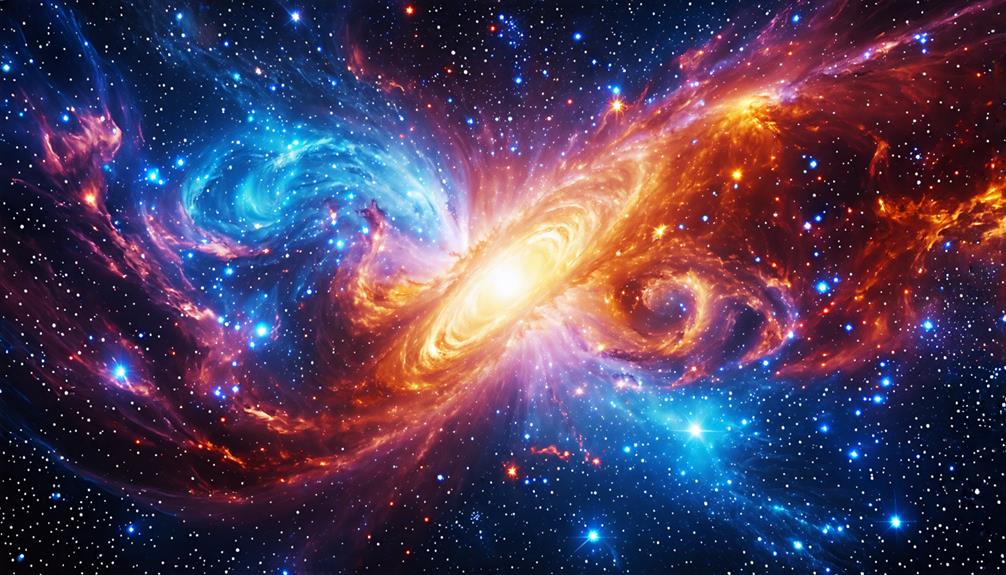Quantum Entanglement Across the Cosmos: The Mysterious Connection of Particles

Quantum entanglement is a phenomenon that connects particles across vast distances, fundamentally challenging our understanding of space and time. When you explore how entangled particles are created and the role measurement plays in this complex interaction, you may find yourself questioning the very nature of reality. What are the implications for our concepts of individuality and determinism? The answers could surprise you, prompting even deeper questions about the universe.
Understanding Quantum Entanglement
Quantum entanglement connects particles in such a way that measuring one instantly reveals the state of the other, regardless of the distance between them. This phenomenon challenges classical physics and raises profound questions about the nature of reality. Think of entangled particles as two dancers whose movements are perfectly synchronized, no matter how far apart they are. Albert Einstein famously called this 'spooky action at a distance,' underscoring the peculiar implications of quantum mechanics.
John Bell's theorem, formulated in 1964, provides a framework for testing the predictions of quantum mechanics against classical local realism. Experiments based on Bell's theorem have consistently shown that entangled particles exhibit this instantaneous connection, reinforcing the non-local nature of quantum mechanics. Measuring the state of one particle immediately determines the state of its partner, highlighting the intricate interplay between entangled particles. This phenomenon offers a fascinating glimpse into the complexities of the quantum world, prompting a reevaluation of fundamental principles in physics.
How Entangled Particles Are Created

Entangled particles can be created through various quantum processes that link their states. For example, simultaneous emission of two photons results in entanglement. Techniques like spontaneous parametric down-conversion split a single photon into an entangled pair. Additionally, particle decays, such as those involving the Higgs boson, can produce entangled pairs spontaneously.
Interaction-Induced Entanglement
Entangled particles are formed when two particles interact closely, allowing their quantum states to intertwine and become correlated. This interaction is crucial for establishing entanglement, as it enables the particles to share information in ways that classical physics cannot explain. One common method involves the simultaneous emission of pairs of particles, such as photons, from a single source. In this process, their properties—like polarization—become linked, creating a robust entangled state.
Another intriguing method for creating entangled particles occurs during high-energy events, such as the spontaneous decay of a Higgs boson, which produces pairs of entangled particles exhibiting unique correlations. In laboratory settings, researchers use advanced techniques with superconducting materials at cryogenic temperatures to manipulate and observe these entangled states effectively.
As you delve deeper into the realm of quantum mechanics, you'll encounter ongoing research aimed at discovering new methods for generating entangled particles. These advancements are foundational for developing quantum technologies, which promise to revolutionize fields from computing to secure communication. Understanding interaction-induced entanglement is a stepping stone for investigating these groundbreaking applications.
Photon Emission Techniques
Photon emission techniques frequently enable the creation of entangled particles through nonlinear optical processes, such as spontaneous parametric down-conversion in crystals. In this process, a single photon interacts with a nonlinear crystal, splitting into two lower-energy entangled photons. These photons exhibit correlated properties, which are crucial for applications in quantum technologies.
To enhance the efficiency of generating entangled photons, researchers often cool superconducting metal strips to cryogenic temperatures. This cooling allows for precise manipulation of photons and their entangled states, thereby increasing experimental reliability. The interaction between photons in these setups is pivotal for creating strong entangled pairs, as the degree of correlation between them hinges on their interaction.
Ongoing research in diverse photon emission techniques continues to push the boundaries, enabling new methods for generating entangled particles. As you explore the world of quantum technologies, these innovative approaches are essential to watch. They not only deepen our understanding of the quantum realm but also lay the groundwork for advancements in quantum computing and secure communication.
Higgs Boson Breakup
The decay of the Higgs boson is a compelling process for generating pairs of entangled particles, highlighting the intricate interplay between fundamental particle interactions and quantum correlations. Upon decay, the Higgs boson can yield entangled particles such as photons or fermions. The conservation of quantum numbers ensures that measuring the properties of one particle instantaneously reveals the properties of its entangled partner, embodying the principles of quantum mechanics.
| Aspect | Details |
|---|---|
| Particles Produced | Photons or Fermions |
| Quantum Correlations | Measurement of one particle's properties determines the other's |
| Significance | Advances understanding of particle physics |
Research into this entanglement process via Higgs boson decay is pivotal, offering profound insights into the fundamental forces that shape particle physics. Experimental evidence has confirmed the existence of these entangled states, validating quantum mechanical predictions and reinforcing the Standard Model. Mastering the generation of entangled particles through Higgs boson interactions paves the way for innovations in quantum technologies, including quantum computing and secure communication systems.
The Role of Measurement

Measurement plays a fundamental role in quantum mechanics by determining the states of entangled particles and collapsing their superposition. When one particle in an entangled pair is measured, it instantaneously fixes the state of its counterpart, regardless of the distance between them. This phenomenon exemplifies the unique nature of quantum mechanics and defies classical intuitions.
Key aspects of the role of measurement in entanglement include:
- Measurement forces entangled particles to adopt specific values, such as spin or polarization.
- Despite appearing random, the results from measurements are correlated.
- Experiments validating Bell's theorem have ruled out local hidden variable theories.
- No information is transmitted faster than light, maintaining the principles of relativity.
Understanding measurement is crucial for comprehending the interaction of entangled particles. It underscores the interconnectedness of particles across vast distances and highlights the unique challenges posed by quantum mechanics, reshaping our understanding of reality.
Scientific Perspectives and Challenges

Quantum entanglement challenges our traditional understanding of physics, signaling a paradigm shift and prompting ongoing research to uncover its complexities and applications. Investigating this phenomenon reveals how entanglement reshapes our view of reality itself.
Puzzling Nature of Entanglement
Quantum entanglement challenges our understanding of physics, compelling a reevaluation of reality and particle interactions. Often termed 'spooky action at a distance,' this phenomenon defies classical notions of locality and causality. Key aspects include:
- Entangled particles can instantaneously influence each other's states, regardless of distance.
- Experiments validating Bell's theorem show that local hidden variable theories cannot account for the strong correlations observed.
- The peculiar traits of entanglement challenge existing paradigms in physics.
- Mastery of entanglement is crucial for advancements in quantum computing.
Despite decades of research, the mechanisms underlying entanglement remain elusive, continuing to puzzle physicists and prompting a rethinking of fundamental concepts. As researchers delve deeper into quantum theory, they acknowledge that entanglement is not just a curiosity but a cornerstone of modern physics, with the potential to reshape our understanding of the universe.
Paradigm Shift in Physics
The emergence of quantum entanglement signifies a profound paradigm shift in physics, challenging established beliefs about reality and urging a reexamination of our understanding of the universe. This phenomenon, where particles can instantaneously influence one another regardless of distance, defies classical notions of locality and causality. The 1935 EPR paradox, proposed by Einstein, Podolsky, and Rosen, questioned the completeness of quantum mechanics by highlighting its implications for local realism.
John Bell's theorem, formulated in 1964, provided a method to test local hidden variable theories against quantum predictions. Numerous experiments have since consistently supported the predictions of quantum mechanics, further solidifying the view that entangled particles share a unique, non-local connection. This acceptance of quantum entanglement's 'weirdness' reflects a significant paradigm shift, moving from deterministic classical views to embracing the probabilistic nature of quantum mechanics. As you explore these scientific advancements, you may find yourself engaging in philosophical debates about the nature of reality and interconnectedness, contemplating a deeper level of unity within the universe that quantum entanglement suggests.
Ongoing Research Endeavors
Research into quantum entanglement is expanding our understanding of physics, revealing both promising opportunities and complex challenges. In delving deeper into quantum physics, you'll find that entanglement experiments have validated Bell's Theorem, questioning classical concepts of hidden variables. Researchers are now exploring the intricate nature of entangled states, which hold significant implications for technology and philosophy.
Key areas of current research include:
- Investigating non-locality and the instantaneous influence between entangled particles
- Developing quantum computing technologies that leverage entangled states
- Enhancing quantum cryptography for secure communication
- Innovating methods for generating entangled particles, such as photon emission
These research efforts underscore the potential of entanglement to transform various fields. However, philosophical debates about the nature of reality and information transfer continue, prompting scientists to reevaluate their perceptions of the universe. Exploring this topic will provide insight into the profound complexities and transformative potential that entanglement brings to both science and our understanding of existence.
Technological Applications of Entanglement

Entangled particles are pivotal in advancing technologies such as quantum computing, secure communication, and advanced sensing. In quantum computing, these particles act as qubits, enabling exponentially faster computations compared to classical bits. By leveraging the unique properties of entangled particles, we unlock unprecedented computational capabilities. For secure communication, quantum key distribution (QKD) employs entangled particles to ensure any eavesdropping attempts are instantly detectable due to disturbances in the entangled state, offering a level of security unattainable by classical methods.
Additionally, entangled particles enable quantum teleportation, allowing quantum information to be transmitted across distances without physically moving the particles. This revolutionary capability enhances the prospects of quantum communication networks, paving the way for ultra-secure data transmission and the potential development of a global quantum internet.
Philosophical Implications of Entanglement

Quantum entanglement challenges our understanding of separateness and locality, revealing a profound interconnectedness in the universe that aligns with philosophical concepts of unity and interdependence. Often referred to as 'spooky action at a distance,' this phenomenon raises fundamental questions about the nature of reality. Entangled particles influence each other instantaneously, defying classical physics and necessitating a reevaluation of traditional cause-and-effect relationships.
Key philosophical implications to consider include:
- Nature of Existence: Is reality governed by determinism, or is it shaped by probabilistic events?
- Hidden Variables: Are there underlying factors that could make quantum mechanics more complete?
- Interconnectedness: How does entanglement challenge our perception of individuality and separateness?
- Consciousness: Does observation play a role in determining reality?
Exploring these questions reveals that quantum entanglement is not just a scientific phenomenon but a gateway to deeper philosophical inquiry.
Conclusion
Exploring quantum entanglement reveals a domain that profoundly challenges our understanding of reality. The instantaneous connection between particles, regardless of distance, prompts a reevaluation of concepts like individuality and determinism. Investigating its scientific and technological applications, you realize entanglement is not merely a phenomenon but a gateway to profound philosophical questions. Embracing this mystery encourages new ways of thinking about the universe, pushing the boundaries of what we thought possible.




